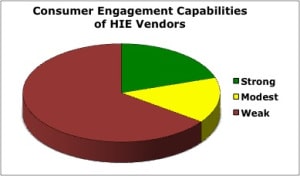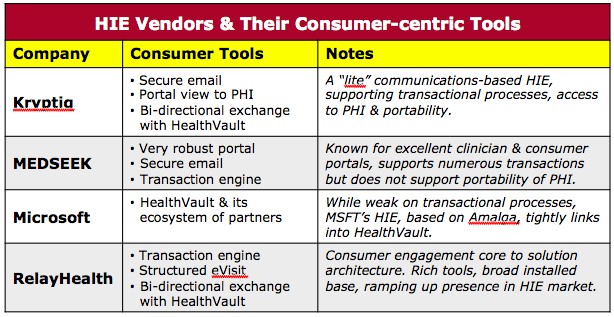In Monday’s post, Chilmark reflected upon a piece that Peter Hudson, co-founder of Healthagen, the developers of mHealth app iTriage wrote for mobihealthnews. In that article, Peter talked about the utility of an mHealth-based PHR (iTriage recently launched such capabilities), but in our post, we countered that today, it is still far too difficult for a consumer to pull together their personal health information (PHI) to create a truly longitudinal record. This will likely stunt the efforts of companies such as Healthagen who are trying to offer consumers a PHR – the hassle factor is still far too great to overcome.
Now we will look at the red hot space of Health Information Exchanges (HIEs).
As local, regional or even statewide aggregators and distributors of health data to facilitate care coordination, HIEs have the potential to play a pivotal role in helping a consumer create and manage their PHI. Now that does not mean that the HIE has to offer the consumer a PHR per se, but what an HIE may be able to do is offer the consumer an ability to have a portal view into their PHI that resides within the context of a given HIE. Better yet, why not have as a condition of receiving some of that federal largesse of $564M for state HIE programs that these HIEs support “Blue Button” functionality allowing a consumer to readily download or export their PHI to wherever the consumer desires.
Ah, but we digress.
The purpose of this post is to extract a couple of data points from our forthcoming HIE report as they pertain to consumer engagement. Unfortunately, it is not a pretty picture.

The following table provides a brief snapshot of those HIE vendors that have what Chilmark considers strong consumer engagement tools. Two of those vendors, Kryptiq and MEDSEEK are somewhat difficult to classify as an HIE in the traditional sense, thus you will not find them running under the covers at your local RHIO. Microsoft is still new to the HIE market with one HIE live in Milwaukee and another in D.C.. While Microsoft’s platform offers these HIEs the potential for bi-directional communication with HealthVault, that capability, to the best of our knowledge has not been tested at either of these HIEs. Also, it is important to note that the Microsoft HIE solution offers little with regards to support for transactional processes (appointment scheduling, Rx refill, eVisit, etc.). RelayHealth is the remaining HIE vendor that actually has some of the more robust consumer tools in the market (they received fairly high ratings in our previous iPHR Market Report), so this is not too much of a surprise.
Now it is not necessarily the fault of laggard HIE vendors that today, their solutions offer weak consumer tools. Frankly, the market has not asked for them. Even as recently as last year when the various HIT policy committees were meeting in Washington to set policies for the HITECH Act and the funding to come, the committee on HIEs, in one of their seminal meetings, completely ignored the consumer role in an HIE. Shameful.
But this will change in due time. MEDecision and Carefx are building out their consumer-facing capabilities and we are sure others will add consumer functionality in time, most likely via partnerships or an occassional acquisition as market is moving too fast for an internal build-out. in the meantime, those vendors that have this capability bring to market competitive differentiation.
While this is all well and good, another development is also taking place, NHIN Direct – something that Microsoft’s chief architect, Sean Nolan mentioned in his comment to our Monday post. What role might a secure, lightweight communication system play within the broader context of HIEs, aggregated PHI, consumer access and potentially control of their PHI? A lot of questions to ponder that we will be looking into further over the next few days





John:
“Better yet, why not have as a condition of receiving some of that federal largesse of $564M for state HIE programs that these HIEs support “Blue Button” functionality allowing a consumer to readily download or export their PHI to wherever the consumer desires.”————— there are some earlier initiatives that will be leveraged by State HIEs. As an example – State of Florida – details here
http://www.ncvhs.hhs.gov/090521p1.pdf
https://ahca.healthtrioconnect.com/login.cfm
Cheers!
John,
Good post and you highlight one of the key areas of HIE that one can expect to mature in the near future. I’ve seen HIEs generally offer one of four flavors of consumer involvement:
1. The HIE routes data over to Google or Microsoft and lets those PHRs deal with the data and the consumer. This is a simple option for an HIE vendor – the integration work is a relative piece of cake and both are well recognized solutions.
2. The HIE offers a portal for consumers to interact with their data from across the HIE. This is similar to #1 but with a more tightly coupled and/or in-house developed approach. The outcome is similar in that the patient is an HIE participant and may have access and interaction with data and providers across the HIE, at the HIE level.
3. The HIE offers “sub portals” for consumers to interact with providers and their data – putting the consumer access point not at the highest HIE level but rather at a level lower, tied to provider organizations. This approach may afford a tighter bond between patients and their providers, and can tailor interactions, services, and value to consumer *and* provider preferences.
4. None.
The third option I find interesting as, done right, it can bring significant value to providers and their patients. It also relieves the HIE from some of the governance, privacy, and stewardship issues that can occupy a lot of an HIE’s time.
Standards and broad adoption are commoditizing the connectivity parts of HIE… it is these value-adds that will differentiate in the future.
Tom, thanks for the examples. Yes, most States are at least considering some aspect of citizen access to their PHI within an HIE, but there is absolutely little, if any consistency. Maybe this just points to the immaturity of the market.
Chris, always good to get feedback from an HIE vendor that is actually out there in the market and attempting to address this issue of citizen access and engagement with their PHI to better manage their health or that of a loved one.
As with any approach, there are always trade-offs. For example, while Option 3 may lead to a more interactive experience with say one’s primary care physician, it does not necessarily provide the citizen with a true and complete longitudinal record, unless of course all care interactions, meds, labs, etc all funnel back to the PCP. Option 3 is typically found in private HIEs, say an IDN. Option 2 is what I have seen many multi-stakeholder HIEs looking to provide but issues of engagement, consent and control are challenges. Option 1 is probably the easiest to implement/deploy, but today, consumer/citizen knowledge as to why they should even care is extremely low and there is a substantial amount of concerns regarding privacy and security of PHI (often misplaced) among consumers in using either Google or MSFT.